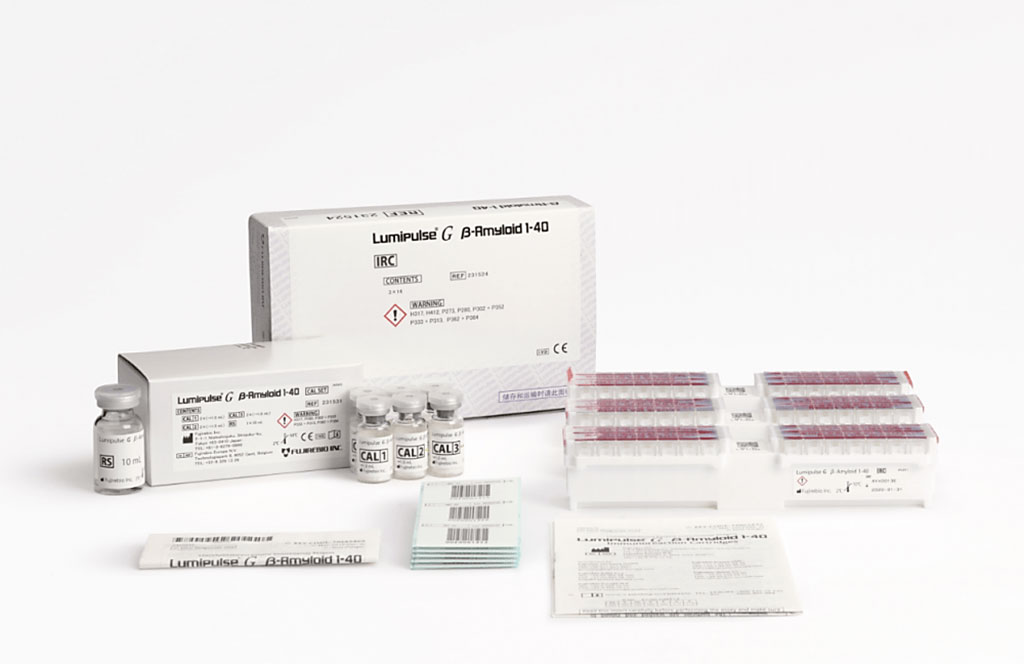APOE Gene Influences Alzheimer's Symptoms, Biomarkers in Down Syndrome
By LabMedica International staff writers
Posted on 22 Jul 2021
Individuals with Down syndrome (DS) constitute a population at ultrahigh risk of developing Alzheimer disease (AD) because of trisomy of chromosome 21, which harbors the amyloid precursor protein (APP) gene.Posted on 22 Jul 2021
The apolipoprotein E (APOE) ε4 allele is the most established genetic risk factor for sporadic AD and has been consistently associated with earlier AD symptoms and pathology in the general population. A similar disease-accelerating feature might exist in DS given that studies in this population have reported that ɛ4 allele carriers show an earlier onset of clinical symptoms and greater amyloid burden than non-carriers.

Image: The Lumipulse G β-amyloid 1-40 assay kit (Photo courtesy Fujirebio)
An international team of Neurologists and their colleagues led by those at the Hospital of the Holy Cross and Saint Paul (Barcelona, Spain) recruited adults with DS. In Barcelona, Spain, adults with DS were recruited from a population-based health plan that was developed for the screening of AD from which the Down Alzheimer Barcelona Neuroimaging Initiative cohort. In the UK, participants were selected from a convenience sample that was recruited from services for people with intellectual disabilities in England and Scotland. Of 464 participants, 97 were APOE ε4 carriers and 367 were non-carriers.
DNA was extracted from peripheral blood by technicians who were blinded to clinical and biomarker data, and APOE genotyping was determined by polymerase chain reaction amplification. Participants were dichotomized according to the presence of at least one ɛ4 allele. Plasma levels of phosphorylated tau 181 (pTau181) and neurofilament light chain (NfL) were measured using single molecule array technology (Simoa; Quanterix, Billerica, MA, USA). The CSF levels of amyloid-β peptide 1-40 (Aβ1-40), Aβ1-42, pTau181, and total tau were quantified using a fully automated platform (Lumipulse; Fujirebio, Malvern, PA, USA). The CSF NfL levels were measured with enzyme-linked immunosorbent assay (NF-Light Assay; UmanDiagnostics, Umeå, Sweden).
The investigators reported that no differences between the two groups were found by age or sex (51 male carriers [52.6%] versus 199 male non-carriers [54.2%]). APOE ɛ4 allele carriers compared with non-carriers presented with AD symptoms at a younger age and showed earlier cognitive decline. Locally estimated scatterplot smoothing curves further showed between-group differences in biomarker trajectories with age as reflected by non-overlapping CIs. Specifically, carriers showed lower levels of the CSF Aβ1-42 to Aβ1-40 ratio until age 40 years, earlier increases in amyloid PET and plasma pTau181, and earlier loss of cortical metabolism and hippocampal volume. No differences were found in NfL biomarkers or CSF total tau and pTau181. Voxelwise analyses showed lower metabolism in subcortical and parieto-occipital structures and lower medial temporal volume in APOE ɛ4 allele carriers.
The authors concluded that APOE ɛ4 allele carriers (compared with non-carriers) showed an earlier decline in episodic memory, earlier clinical diagnosis of symptomatic AD, earlier changes in AD biomarkers, and differences in the pattern of neurodegeneration. These findings demonstrated that the APOE ɛ4 allele can modulate both the clinical expression and biomarkers of AD in a genetic form of the disease, such as in DS, and emphasize the importance of the APOE genotype for future clinical trials in DS. The study was published on July 6, 2021 in the journal JAMA Neurology.
Related Links:
Hospital of the Holy Cross and Saint Paul
Quanterix
Fujirebio
UmanDiagnostics














